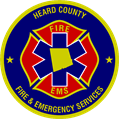


Heard County Fire & Emergency Services
11816 HWY 100
Franklin, GA 30217
Phone: (706) 675-6186 (TTY 711) Fax: (706) 675-3195
11816 HWY 100
Franklin, GA 30217
Phone: (706) 675-6186 (TTY 711) Fax: (706) 675-3195

FIND US ON:
EMAIL US:



Family Fire & Burn Safety Tips
Every year, many children lose their lives at home from fire and burns. Young children can learn to stay away from hot things. They can learn what to do if there is a fire. Children feel safer when they know the plan, but someone has to teach them. Teachers at school help, but the most important teacher is YOU. You are the best person to teach your children how to be safe in your home.
The nonprofit Home Safety Council has created Start Safe: A Fire and Burn Safety Program for Preschoolers and Their Families. It includes some things you can do to help keep your children safe. Let your children know that you and other grownups will help them stay safe.
The nonprofit Home Safety Council has created Start Safe: A Fire and Burn Safety Program for Preschoolers and Their Families. It includes some things you can do to help keep your children safe. Let your children know that you and other grownups will help them stay safe.
•
Keep hot things away from children.
•
Lock up matches and lighters.
•
Stay in the kitchen when you cook.
•
Do not let children use the stove or microwave oven.
•
Turn pot handles in.
•
Test hot food before giving it to your child.
•
Keep appliances and cords out of reach.
•
Blow out candles when adults leave the room.
•
If you smoke, smoke outside.
•
Put water on cigarette and cigar butts before dumping them in the trash.
PREVENT BURN INJURIES!
•
Turn your water heater down to 120 degrees Fahrenheit.
•
Put in a special tub spout and shower head that will shut off the water if it gets too
hot.
hot.
•
Test the water before your child gets into the tub.
•
When you carry your child, don't carry a hot drink too.
•
Keep hot drinks away from the edge of the counter or table.
•
If you burn your skin, cool it with cool water for 3-5 minutes. Do this right away.
•
Do not put ice, butter, or lotion on the burn.
•
If the burn looks bad, see your doctor or call 911.
Young children and older adults have thinner skin. They burn more quickly.
USE SMOKE ALARMS!
Smoke alarms help keep your family safe. Fire spreads fast and makes smoke. Smoke can kill. Smoke sets off smoke alarms. Most fires that kill start at night while you are sleeping. Smoke alarms make a loud sound to wake you up.
•
Make sure you always have smoke alarms that work.
•
Put your smoke alarms in or near rooms where people sleep.
•
Have a smoke alarm on every level of your home.
•
Place them up high on the wall or on the ceiling.
•
Test smoke alarms each month.
•
Change batteries once a year or sooner if the alarm chirps.
•
Do not take out the batteries to stop the alarm sound.
•
Replace your smoke alarms every 10 years.
•
Get your family out when you hear the alarm.
MAKE YOUR HOME SAFER!
MAKE A HOME ESCAPE MAP!
•
Make a plan with your family to get out fast if there is a fire.
•
Draw a map of your home.
•
Show the rooms, doors, and windows that go outside.
•
Know two ways out of every room and mark them on the map.
•
Have a safe place to meet outside, in front of, and away from your home.
•
Plan who will call 911 when you are outside.
•
Practice a family fire drill twice a year.
•
Go over the map and plan with your family.
•
Make sure windows and doors open easily, but do not practice going out the
window.
window.
•
Keep stairs and doorways clear.
•
Hang up the map so everyone can see it.
GET OUT IF THERE IS A FIRE!
•
Get your family out fast when you hear the smoke alarm.
•
Get out if you see or smell smoke.
•
Help your children get out.
•
Go to your family meeting place.
•
Go outside and stay outside! Do not go back into your home.
•
Call 911 from outside.
•
If you can't get out because of smoke, close the door. Stay low by a window where the fire fighters can find you quickly. Safer air to breathe is low, near the floor.
•
If your clothes are on fire, Stop, Drop, and Roll over and over. Then cool the burn with cool water.
Visit www.MySafeHome.org For More Information
© 2020 Heard County Government. All Rights Reserved. Created and Administered by the Heard County IT Department.

